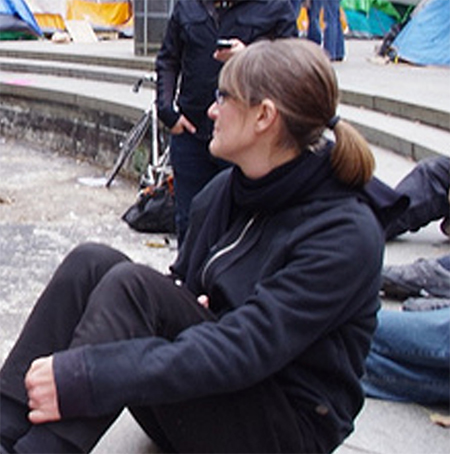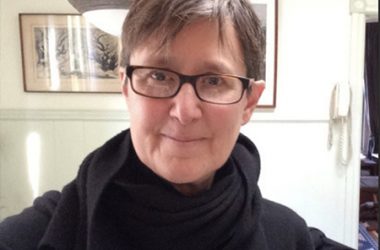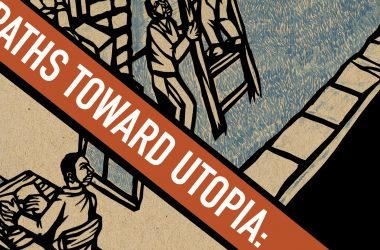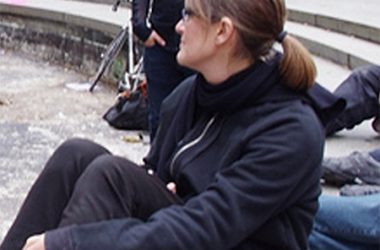By Cindy Milstein

Too many people avert their eyes to the pain of this world. As a friend of mine pointed out the other day, it’s a “natural” response; pain hurts, so people try to rid themselves of pain, by whatever means necessary.
Too many people avert their eyes from the past, present, and future, and increasingly, from each other. Interdependence, intimacy, insight, inspiration, and so much more — all are also out of sight when we avoid gaze, avoid eyes.
Another friend long ago told me that I have sad eyes, even when smiling. I am none too good at not looking squarely into the eyes of suffering, seeing it everywhere, which of course, is where it resides these days, particularly if one resides in San Francisco’s Mission.
“What’s your addiction to deal with the pain, to forget suffering for a while?” another friend queried recently.
I had no answer, save for “I try to swim laps daily.” But that wasn’t quite accurate. Often, too often, my goggles mist up in the pool.
I think it is true that eyes are the mirrors of the world. I don’t know how else to see humanity, to sustain and grow my own humanity, other than to look into other eyes. But I fear that the pain of this world, which is everywhere, becomes etched on to my pupils, reflecting outward, aching inward.
The suffering of self and society, our selves in this society, is glimpsed clearly when we make eye contact. Our pupils can’t lie, even though too many people try to blind themselves to the truths of this world in a vain effort at vanquishing pain.
The problem isn’t the pain, although the task of rebels should be to alleviate unnecessary suffering and accentuate lives worth living — for all. The problem is not seeing, or being compelled to see alone, because too many others avert their eyes from the pain of this world.
Last
night, I looked into many eyes at Sembrando rebeldía / Cosechando
Libertad (badly translated, yet hopefully catching the spirit, as
“sowing rebellion / harvesting freedom”), an opening for art by various
printmakers, several of them friends, at Artillery Ag on Mission
Street. This opening was just a block away from where vintage lowriders
paid homage to Alex Nieto, who would have been twenty-nine this month,
save for his murder by SFPD cops a year ago, March 21, 2014. Alex was
executed while he sat eating dinner and gazing over San Francisco from
atop Bernal Hill, which offers a panoramic view, as if this city has no
strife.
On this anniversary day, before the art opening, there was remembrance aplenty, with images of Alex aplenty, his eyes looking outward at us, the many of us, in this community that has seen — and yet sees — so much pain. Like many before him, gunned down by police, Alex has become honored, mourned, and remembered in many ways, but the one that seems to stick in the public mind’s eye is Alex’s face, via art, gazing intently out to the life he has lost.

The art of remembering, art that doesn’t let us — nor those who killed Alex, I trust — forget.
There has been a year of remembering here in #LaMission. Walks every month, on the 21st, up to Bernal Hill, to the spot where Alex was killed, a spot now part shrine, part grave, part community convergence, and and part contested terrain. Someone, or several someones, have repeated torn asunder the flowers, pictures, and other mementos marking the place where SFPD bullets rained down without reason — except the pain of white supremacy and capitalism, among others.
Standing on this hill yesterday, thinking back to last year on this hill, one could see the difference that such public remembrance makes. Alex’s parents wrote about it, and read those words out loud on this hill yesterday, using their own “I’s” to reflect on their pain yet also the ways that within a community of remembrance, they have found new ways of seeing a world of pain that affords, too, beauty, strength, interconnection, and even joy, despite loss, because of loss. (http://justice4alexnieto.org/2015/03/21/words-from-refugio-and-elvira-nieto-on-the-one-year-community-commemoration-of-alex-nieto-englishspanish/.)
It doesn’t make the pain go away; we all, I think, saw it yesterday, as plain as day, and felt it as well.
But holding it together, looking into the eyes of so many of us who have walked this hill, up and down, together for twelve months now, who have gone to other vigils for others murdered by SFPD, other sham “town meetings” put on by cops, other court dates of injustice, other Ferguson-inspired demonstrations and FTP marches, other do-it-ourselves community events and projects, other art shows with portraits of those killed by police, this March 21, 2015, was part mourning, part honoring, part celebrating, and part of the increasingly powerful landscape of collective resistance going on in the grieving Mission. For there is, day by hour, too much to grieve, much less comprehend.
After this procession of remembrance up and down Bernal Hill, march along Folsom and 24th streets, stopping to recollect and honor other young people, mostly brown skinned, who died at the hands of police or other tensions caused, no doubt, by living in the midst of class war, austerity, gentrification — the long history dating back to the first peoples of stolen land, stolen lands when the first missionaries stepped foot on these grounds — an exuberant celebration erupted on Mission Street, outside the Mission Cultural Center. A banner hung from the building, more art of remembering by Keep Hoods Yours: “Amor for Alex.” It was not disrespectful festivities but rather a reclaiming of neighborhood, culture, space, and how when we see the pain of this world together, we discover much else in these eyes of ours: determination, resilience, empathy, generosity, care, and so much more that makes us, again, see and enact our humanity.

In this Mission with so many tech devices that allow people to avert their eyes to the pain of this world, we who see, can see fully why we struggle: to stop the displacement, dispossession, disappearances by sowing rebellion, harvesting freedom, which means, when it comes down to it, turning toward each other and really seeing that we — the we who are brave enough to see, who are fighting to stay put, to stay alive — are in this world of pain together. Which makes it so much less painful.
That is the “secret” written plainly on our faces: we can bear all within caring communities, even if we don’t choose this world that offers so much more pain than humans are meant to bear, because too many humans eye themselves, whether for power, greed, or hate.
At the art gallery, packed tight, I was surrounded by eyes, those on lino and woodcuts, those in the faces of friends, comrades, and new acquaintances. Everywhere I turned: eyes. But not “I’s.”
My artist friends were awkward about the price tags on their work; they print not as object for a wall in one of the luxury condos mushrooming up nearby but instead as weapon, as education, as political action, as the beauty and heart we need to hold dear in order to go on fighting, as the reason to go on fighting — which maybe simply rolls into that best of four-letter words: love.
These friends of mine, who I met in this beloved and pained neighborhood on the streets at an “evict the cops; defend our homes” demonstration, do this art as community.
The eyes of rebels gazed out at us last night, from the artworks of remembrance. And when I looked in the eyes of my neighbors and friends, I saw rebels, too, bonded together in the art of our ability to see — generations of pain past, those without papers, those whose lands and lives were brutally taken from them, those many others who are also misfits, disposable, persecuted and tortured and killed. Yet generations, too, of peasants and workers, poor and enslaved, of all races and religions, all politics and cultures, who resisted — and resist still. Who win autonomous communities and hang on to unceded territory, who extend mutual aid and enact solidarity, who remember each others’ victories and poignant defeats, and willingness to struggle again.
Pain doesn’t break us when shared. We need to embrace it, see it, remember it. For pain shared opens up windows on to what a world with a lot less pain feels like, in living and breathing practices, even if in the small corner of this world called #LaMission this March 2015.
If I am addicted to anything to deal with pain, to alleviate the suffering, it is, no doubt, no question: open-eyed and open-hearted community, which is another way of seeing and saying love.
I think my eyes might even have sparked a bit yesterday.

* * *
If you want to get word when I put out new musings, sign up at cbmilstein.wordpress.com. Enjoy, share, reprint, post, tweet any of my writings as long as it’s free as in “free water” and “freedom.”(Photos by Cindy Milstein, March 21, 2015, on the year anniversary of the death of Alex Nieto, murdered by SFPD; the first photo poorly captures a gorgeous print by my friend-as-family Jose Cruz; the second photo shows Oree Originol’s image of Alex on a lowrider; then there’s the #KeepHoodsYours banner; and finally, another print by Monica Alfaro.)




